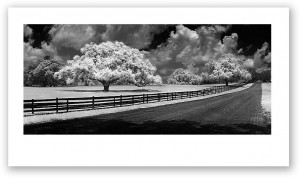Infrared light is all around us. We can’t see it, but our cameras can. The problem is that IR light effects the camera’s ability to record the visible light correctly. Most manufacturers put IR blocking filters over the digital camera’s sensor to prevent the IR light from causing a problem. Some cameras don’t have this filter, or have a weak version of one. I started shooting infrared images with a Fuji S2, which can “see” infrared light right out of the box.
There’s a little trick to tell if your camera has the IR blocking filter or not. Take the remote control from your television and point it at your camera. While pushing down any button on the remote, take a picture of the infrared emitter located on the front end of the remote. (NOTE: You may see a little red light or nothing at all. either way there is a IR light being created each time you push a button) If, in your photo, you see a light coming from the remote, congratulations your camera “sees” IR light. All you have to do is buy an IR filter ( 52mm, 55mm, 62mm, 72mm, 77mm ) to help the camera “sort” the IR light from the visible light. I used the #87 Infrared filter with good results. There are others you can try.
If your image doesn’t capture any light, like my Nikon D700 doesn’t (see image above), there’s still an option. You can have your camera converted. The upside is you can shoot handheld relatively fast-speed IR photos all day long with no lens filter. And of course with every upside, there’s always a downside. The downside is that once converted, your camera can only take infrared images.
FYI – The infrared light captured by digital still cameras is reflective. It has to do with the frequency of the light waves. In other words, the still camera does not see heat or radiating infrared light like the night vision video cameras you might see on police shows. So just don’t expect to have night vision with your DSLR.
Infrared photography is a blast and I’ve found it to be very rewarding. Check it out, it could open up new doors for your creative photography!
This article comes from kentweakley edit released

